
Concept explainers
(a)
Interpretation: The type of coal that contains large percent mass of carbon needs to be determined using the given charts.
Concept Introduction : The substance produced from dead plants and animal remains which are buried and go through high pressure and heat over a long time period is coal. Coal is a solid fossil fuel consisting of carbon. There are various types of coal, such as, lignite, bituminous etc.
(a)
Answer to Problem 2RQ
Bituminous coal has large percent mass of carbon.
Explanation of Solution
Given pie chart for the Lignite coal is as follows:
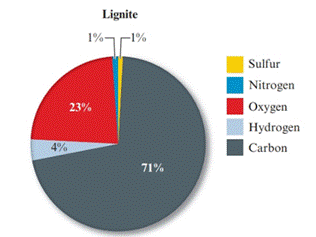
Given pie chart for the Bituminous coal is as follows:
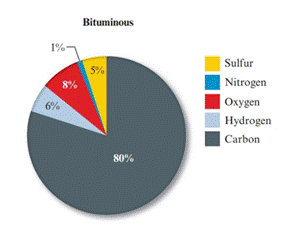
In the lignite coal, percent of carbon is 71% and in the bituminous coal, percent of carbon is 80%. So, the coal having large percent mass of carbon is bituminous coal.
(b)
Interpretation: The type of coal that contains large percent mass of sulphur needs to be determined using the given charts.
Concept Introduction : The substance produced from dead plants and animal remains which are buried and go through high pressure and heat over a long time period is coal. Coal is a solid fossil fuel consisting of carbon. There are various types of coal, such as, lignite, bituminous etc.
(b)
Answer to Problem 2RQ
Coal that contains large percent mass of sulphur is bituminous coal.
Explanation of Solution
Given pie chart for the Lignite coal is as follows:
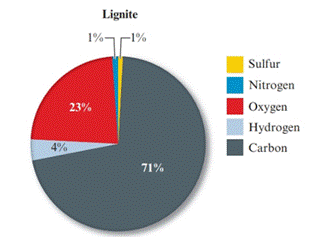
Given pie chart for the Bituminous coal is as follows:
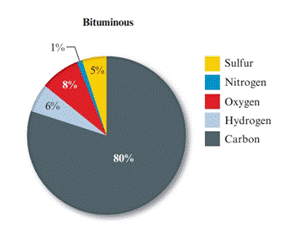
In the lignite coal, percent of sulphur is 1% and in the bituminous coal, percent of carbon is 5%. So, the coal having large percent mass of sulphur is bituminous coal.
(c)
Interpretation: The element present in equal amounts in both the types of carbon (coal) needs to be determined.
Concept Introduction : The substance produced from dead plants and animal remains which are buried and go through high pressure and heat over a long time period is coal. Coal is a solid fossil fuel consisting of carbon. There are various types of coal, such as, lignite, bituminous etc.
(c)
Answer to Problem 2RQ
Nitrogen is present in equal amounts in both the coal.
Explanation of Solution
Given pie chart for the Lignite coal is as follows:
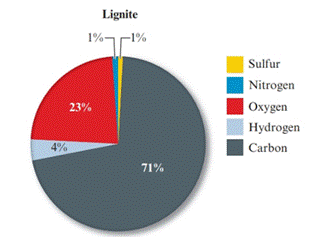
Given pie chart for the Bituminous coal is as follows:
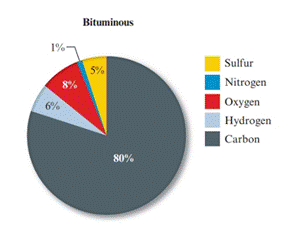
The percentage of nitrogen in both the coal (lignite and bituminous) is 1%. So, nitrogen is present in equal amount in both the coal.
Chapter 10 Solutions
World of Chemistry
- Michael Reactions 19.52 Draw the products from the following Michael addition reactions. 1. H&C CH (a) i 2. H₂O* (b) OEt (c) EtO H₂NEt (d) ΕΙΟ + 1. NaOEt 2. H₂O' H H 1. NaOEt 2. H₂O*arrow_forwardRank the labeled protons (Ha-Hd) in order of increasing acidity, starting with the least acidic. НОН НЬ OHd Онсarrow_forwardCan the target compound at right be efficiently synthesized in good yield from the unsubstituted benzene at left? ? starting material target If so, draw a synthesis below. If no synthesis using reagents ALEKS recognizes is possible, check the box under the drawing area. Be sure you follow the standard ALEKS rules for submitting syntheses. + More... Note for advanced students: you may assume that you are using a large excess of benzene as your starting material. C :0 T Add/Remove step Garrow_forward
- The following equations represent the formation of compound MX. What is the AH for the electron affinity of X (g)? X₂ (g) → 2X (g) M (s) → M (g) M (g) M (g) + e- AH = 60 kJ/mol AH = 22 kJ/mol X (g) + e-X (g) M* (g) +X (g) → MX (s) AH = 118 kJ/mol AH = ? AH = -190 kJ/mol AH = -100 kJ/mol a) -80 kJ b) -30 kJ c) -20 kJ d) 20 kJ e) 156 kJarrow_forwardA covalent bond is the result of the a) b) c) d) e) overlap of two half-filled s orbitals overlap of a half-filled s orbital and a half-filled p orbital overlap of two half-filled p orbitals along their axes parallel overlap of two half-filled parallel p orbitals all of the abovearrow_forwardCan the target compound at right be efficiently synthesized in good yield from the unsubstituted benzene at left? starting material target If so, draw a synthesis below. If no synthesis using reagents ALEKS recognizes is possible, check the box under the drawing area. Be sure you follow the standard ALEKS rules for submitting syntheses. + More... Note for advanced students: you may assume that you are using a large excess of benzene as your starting material. C T Add/Remove step X ноarrow_forward
- Which one of the following atoms should have the largest electron affinity? a) b) c) d) 으으 e) 1s² 2s² 2p6 3s¹ 1s² 2s² 2p5 1s² 2s² 2p 3s² 3p² 1s² 2s 2p 3s² 3p6 4s2 3ds 1s² 2s² 2p6arrow_forwardAll of the following are allowed energy levels except _. a) 3f b) 1s c) 3d d) 5p e) 6sarrow_forwardA student wants to make the following product in good yield from a single transformation step, starting from benzene. Add any organic reagents the student is missing on the left-hand side of the arrow, and any addition reagents that are necessary above or below the arrow. If this product can't be made in good yield with a single transformation step, check the box below the drawing area. Note for advanced students: you may assume that an excess of benzene is used as part of the reaction conditions. : ☐ + I X This product can't be made in a single transformation step.arrow_forward
 ChemistryChemistryISBN:9781305957404Author:Steven S. Zumdahl, Susan A. Zumdahl, Donald J. DeCostePublisher:Cengage Learning
ChemistryChemistryISBN:9781305957404Author:Steven S. Zumdahl, Susan A. Zumdahl, Donald J. DeCostePublisher:Cengage Learning ChemistryChemistryISBN:9781259911156Author:Raymond Chang Dr., Jason Overby ProfessorPublisher:McGraw-Hill Education
ChemistryChemistryISBN:9781259911156Author:Raymond Chang Dr., Jason Overby ProfessorPublisher:McGraw-Hill Education Principles of Instrumental AnalysisChemistryISBN:9781305577213Author:Douglas A. Skoog, F. James Holler, Stanley R. CrouchPublisher:Cengage Learning
Principles of Instrumental AnalysisChemistryISBN:9781305577213Author:Douglas A. Skoog, F. James Holler, Stanley R. CrouchPublisher:Cengage Learning Organic ChemistryChemistryISBN:9780078021558Author:Janice Gorzynski Smith Dr.Publisher:McGraw-Hill Education
Organic ChemistryChemistryISBN:9780078021558Author:Janice Gorzynski Smith Dr.Publisher:McGraw-Hill Education Chemistry: Principles and ReactionsChemistryISBN:9781305079373Author:William L. Masterton, Cecile N. HurleyPublisher:Cengage Learning
Chemistry: Principles and ReactionsChemistryISBN:9781305079373Author:William L. Masterton, Cecile N. HurleyPublisher:Cengage Learning Elementary Principles of Chemical Processes, Bind...ChemistryISBN:9781118431221Author:Richard M. Felder, Ronald W. Rousseau, Lisa G. BullardPublisher:WILEY
Elementary Principles of Chemical Processes, Bind...ChemistryISBN:9781118431221Author:Richard M. Felder, Ronald W. Rousseau, Lisa G. BullardPublisher:WILEY





